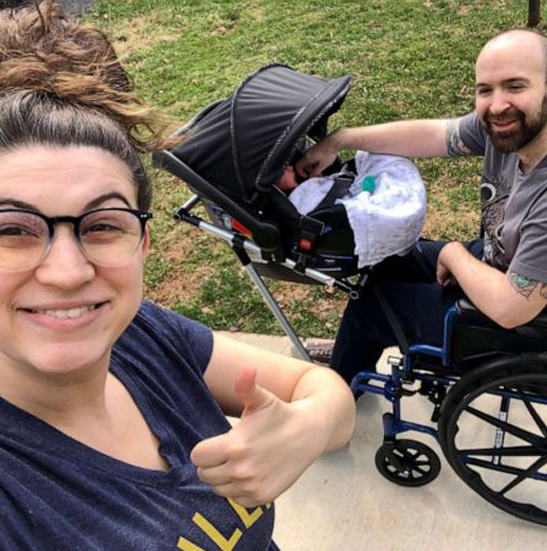High Schoolers Build Device so People in Wheelchairs Can Walk Their Babies

37-year-old Jeremy King underwent an eight-hour brain surgery in 2017, which left him with impaired mobility and speech challenges. His “golf ball-sized” cancerous brain tumor was successfully removed, but he had a new set of hurdles to overcome after the surgery.
“Even going out on a walk is so incredibly difficult for me,” Jeremy told The Washington Post. He said that balance is his biggest struggle, and he often has to use a wheelchair to get around.
His wife, Chelsie King, is a 32-year-old middle school teacher at Bullis School in Potomac. A group of students discovered that one of their teachers was pregnant, and her husband may never be able to walk his own child.
Three years post-operation, Jeremy could not contain his excitement for the baby, but constantly worried how he would be able to parent. “It was an immediate concern,” Jeremy said in a statement. “I was very concerned with the safety of myself and our child especially with Chelsie having to potentially support both of us. It played on my mind constantly which is why it was important for us to find things to help.”
So, Chelsie reached out to Matt Zigler, a fellow educator who runs the school’s creative lab, or BITlab, and teaches a course called “Making for Social Good.”
“We knew we were expecting in March and I asked him if he thought he could build something for us as a personal favor and he had the idea to throw this to his Making For Social Good class and I thought that was an amazing idea,” Chelsie said in a statement.
Ten of Zigler’s students began working on the project they called the “WheeStroll,” dedicating their entire winter semester to the project to be ready for the baby’s arrival in March.
After consulting with the expecting parents, the students knew their design would have to meet three requirements: It had to be safe, easy to maneuver, and something Jeremy could attach and detach without help from others.
Through trial and error, the students successfully created a solid prototype. They connected several metal pipes to securely attach the car seat to the wheelchair and conducted weight tests using 55 pounds of cinder blocks to ensure that the mechanism could safely support a baby.
“It was emotional to see it all come together and to put Phoenix in it for the first time” said Chelsie.
Since receiving the attachment in March, Jeremy has been able to talk Phoenix on several outings by himself. “These students gave me the opportunity to do something I thought I would never be able to do. I’m really grateful,” said Jeremy.


 Previous
Previous
